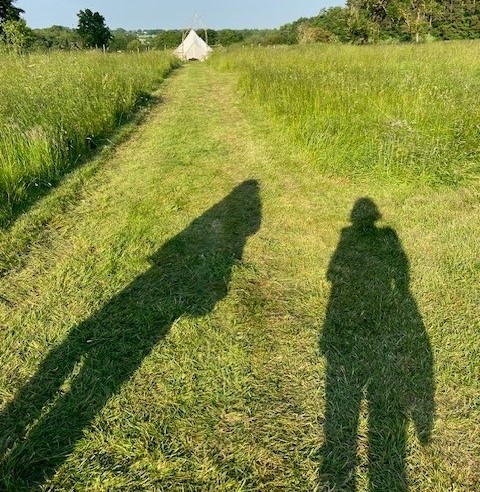I have written and rewritten this blog a hundred times in my head. I’m drawing on personal experience as well as professional. And I know this is delicate, difficult stuff and I might get it wrong. But I have reflections on shared leadership bubbling away… so here goes.
Expat or Immigrant
Growing up I lived in four different countries on three different continents but as a white person with British parents I was labelled an ‘expat’. The unsurprising truth is that my experience of migration was one of privilege and ease. Fuelled by immense discomfort (and guilt) at the treatment of people of colour as ‘immigrants’ – with all the negative framing and rhetoric that has been built around this label – I started to do some homework, leading me to an article from 2015 asking the exact same question I had been asking myself whilst reading (B)ordering Britain by Nadine El-Enany. In the article, Why are white people expats when the rest of us are immigrants?, Mawuna Remarque Koutonin observes and highlights the inherent racism in the term ‘expat’.
Meanwhile, Jones and Okun’s widely shared piece on White Supremacy Characteristics, now updated and with added commentary, available via a dedicated website, WHITE SUPREMACY CULTURE, highlights just some of ways in which Black, Indigenous and People of Colour (BIPOC) are seen as a poor fit against values of perfectionism, urgency, worship of the written word, power hoarding, paternalism and so on. Intersectional consideration of class, gender, sexuality, ability and neurodiversity heap on further layers of inequity. The list has been instrumental in helping lots of us to see what we may not have seen before – that white middle class modes of thinking are privileged in the workplace. Or to put it another way, an ingrained sense of hierarchy and racism prevents (predominantly white) leaders from recognising and embracing the value of multiple perspectives and ways of doing things.
“Lived Experience Leadership”
In several sectors, and a few pioneering organisations within them, there has been a significant and much needed shift away from white supremacist mindsets and a move towards employment of black and brown people, with particular emphasis on employing and/or working with people with first-hand experience of the issues at hand. It has given rise to the term ‘lived experience leadership’. This piece speaks specifically to the issues I’ve encountered in the global health and migration sectors where I’ve had the honour of working alongside some incredible leaders with lived experience – but where a few things have been niggling me.
- Reductive thinking: The increased appreciation of the value of ‘lived experience leadership’ has been extremely encouraging to those of us pushing to shift power in organisations. But there is a real risk of being reductive or tokenistic; we are much more than our ‘lived experience’ and we must not be defined by this alone.
- The burden of expectation: Building on this point, many people have lived and learned experience of a particular issue. But the burden of representation is huge. Expecting a handful of people to understand and represent a huge spectrum of lived experiences is unfair; no one can be expected to speak alone on behalf of many. There is too little support and too much burnout in the social justice sector.
- Activating ‘lived experience’ for systems change should be a choice not an obligation: Not everyone who has lived experience wants to explicitly or overtly use that insight in their work; it tends to come with an expectation to constantly tell your story which can be exhausting and even re-traumatising. Personally I have actively chosen not to work in sectors tackling issues of which I have ‘lived experience’, and I’m aware of the immense privilege I have had in making that choice. I have always felt that it would be too painful to constantly re-visit and re-live these issues. This gives me a very deep respect for those who do work on issues with such close proximity to their own lives. It takes huge strength and it should not be taken for granted.
Shared Leadership
There is still so much more to be done to shift power, and real need to make space for diverse forms of leadership. I know from first-hand experience leading organisations through change that when those with privilege are comfortable with the status quo, meaningful shifts in power can take a long time, even when many allies are speaking up.
At the same time, I don’t believe that people with lived experience of any particular issue should be abandoned to go it alone, with everyone else stepping completely back and away. There is a vital space for allyship and solidarity.
But we are in need of new models for genuinely distributed, shared leadership that enable everyone to bring their unique perspectives and assets together. Models that reject the white supremacist culture embedded in our institutions, organisations, and funding ecosystems which stifle those who offer alternative ways of being, doing and creating impact. And the benefits in shaking up power dynamics can be felt widely; it is not only BIPOC people, but also people experiencing other forms of marginalisation from the ‘default’ modes of thinking and working, including people from working class backgrounds, people living with a disability or being neurodivergent to name just a few.
There is clearly more work to be done to wean ourselves away from hard-wired notions of hierarchy and learn how to share power. This entanglement speaks to our collective reluctance to be really honest about how to bring people together to share leadership space. Let’s model a new normal where equitable, safe spaces exist for us all, and where it is ordinary to see power distributed evenly.
Beyond Representation
In developing shared leadership models, we need to ask ourselves:
- How do shared models of leadership work? How do you assess for aptitude to share power and learn together when you hire into shared leadership positions?
- Once in post, how do you share roles and responsibilities equitably?
- Is access to supportive, reflective space in place for the leaders (think supervision, peer support and coaching)?
- How do meetings run? What is the preparation or papers that are needed? Is there an over-reliance on written documentation? Are we being truly inclusive in how we structure conversations and decision making processes?
- Who is working within their comfort zone and who is being forced to adapt and conform?
Embracing shared leadership is ultimately about losing control. Not ‘sharing power’ on one persons’ terms. None of you is the expat. None of you is the immigrant. Just humans exploring what it means to lead together. That’s a scary thing to do. It requires trust, safety, and a release of ego, to challenge the status quo and imagine new ways of showing up for each other. But the best leaders I see around me are leaning into the possibilities that this opens up for us all.
Who’s with me in exploring this more?
——————————————————————————————
Notes on my own experience of shared leadership which I have drawn upon as I wrote this piece:
- During my time at Primary Care International, I co-led the organisation alongside a deeply experienced and insightful doctor/global health practitioner who split her time between Lagos and London, drawing on the lived realities of health systems in both settings.
- As Interim Director at Play for Progress, I supported the Co-Founders through a process of transition, sharing leadership space with them both as we navigated a period of change and transformation including an exploration of whether shared leadership was the right model for the organisation going forward.
- At Shared Assets, as a Non-Exec Director, I am currently exploring distributed leadership models along a spectrum from conventional hierarchy to cooperative.
——————————————————————————————
For more reading: check out the beautiful resources curated by Devi Leiper O’Malley and Ruby Johnson, previously Co-Leads at FRIDA, the Young Feminist Fund https://www.feministcoleadership.com/

